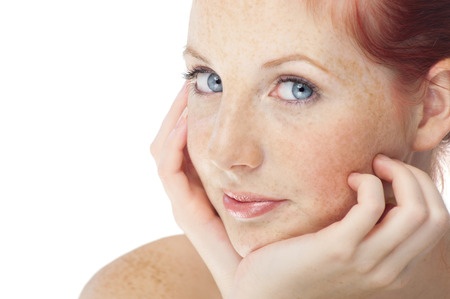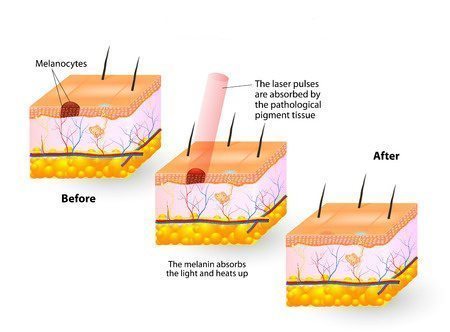
Pigmentation Treatment
What Is Hyperpigmentation?
Skin hyperpigmentation is the brown discolouring in the form of ‘patches’ that appear on the face and body. The most common forms of these brown blemishes are beauty spots, freckles, age spots and lentigines (small brown patches on the skin). This discolouration occurs due to the overproduction of melanin. Melanin is a brown UV absorbing protein pigment which gives our skin colour or pigmentation. The protein production increases or decreases in concentration depending on the stimuli from environmental or internal factors. For example, skin tans in the sunlight because of a higher rate of melanin production. This is happening due to the skin’s natural immune system response put into effect to protect against damage. However, certain areas of the skin may be more sensitive to producing melanin, thus resulting in the appearance of hyperpigmentation. After sun exposure is not present, this pigmentation becomes a concern when it remains in undesirable forms.
The Effect Of The Ozone Layer On The Skin
We must remember that the ozone layer is not as stable and whole as it once was. It does not completely protect us from ultraviolet radiation (UV) anymore because of the holes we constantly create in the layer. Thus, the elevation of radiation exposure is now more concerning than ever. UV radiation is invisible, but its presence surrounds us at all times, on a cloudy day or even at night. Sealing or protecting a room or a place is impossible to prevent radiation from travelling around. Therefore we must take matters into our hands and be proactive in caring for our skin. It is always beneficial to protect our skin with a barrier to prevent damage from radiation (please see our aftercare advice, which details the best care for your skin even if you do not consider pigmentation treatment). In some cases, mild pigmentation can be rectified or improved by simply protecting yourself with our 5 step skincare regime.
When Does Hyperpigmentation Appear In The Skin?
- Tanning: When an individual tans, melanin production is at a higher rate. Although, we usually assume the skin looks brighter, healthier and more radiant. In the case of tanning, the damage also stimulates cell turnover. Although, this can be dangerous due to damage to the ozone layer and individual susceptibility. More sensitive areas may darken more than others, and when the tan fades may leave pigmentation.
- Freckles (ephelis): These can be present from birth or may develop through time as an individual’s exposure to the environment increases. Freckles appear due to a genetic predisposition to produce melanin in small round spots over the face and/or body. They tend to occur in patterned formations on the face and body. The pigmentation that can occur has no set frequency, shape, tone, shade or location. Many people consider them as beautiful features. However, this is not everyone’s view, as we all think and see differently.
- Solar Lentigines (age spots): These brown spots usually develop over the face due to pigmentation that arises later in life. They are similar to freckles as they can vary in number and shade of brown (light or dark). Age spots occur and darken due to a cumulative effect of enhanced exposure to the sun’s damaging rays over time. Again, genetic predisposition and skin type influence their existence. They have a normal number of melanocytes (cells that produce melanin).
- Simple Lentigines: Can occur anywhere over the body and at any age. In contrast to solar lentigines, they do not darken with solar exposure and have an increased number of melanocytes.
- Nevi: These melanocytes group in demarcated nests and appear raised in some cases. Different types exist, and on close examination, they can appear like “fried eggs”; they may contain variable concentrations of melanin or have no distinct architectural shape or size. They are flat or raised, present from birth or develop later in life due to an underlying genetic susceptibility.
- Some diseases have a trait where hyperpigmentation is found commonly in a specific area on the skin. For example Peutz–Jeghers syndrome commonly results in hyperpigmentation around the lips of the sufferer.
How Do We Treat Them?
Our pigmentation treatment consists of a laser that emits light at a specific wavelength to specifically target the melanin protein. When the light is directed onto the skin, it is absorbed by the melanin protein pigment. Melanin is a natural protein with colour characteristics, which allows us to manipulate it in terms of light absorption. Once the melanin has absorbed the light, the heat from the laser stimulates an immune system response. As the melanin in the blemish is in a higher concentration than normal, instigation of natural cell renewal occurs. In effect, the pigmentation treatment prompts the body to notice the increased levels of melanin to balance it out. The pulsing feature of the laser allows us to heat the melanin critically whilst causing minimal damage to the surrounding areas of skin tissue.
The Pigmentation Treatment Process
Gentle cleaning of the skin is necessary to remove chemicals. The treatment area undergoes the application of ECG (Electrical Conductivity Gel). The ECG gel cools the area and ensures optimal light transmission from the applicator to the skin. Clear Medical therapists select the optimum setting which is safe and effective on an individual basis. The skin surface has a quartz applicator placed on it. The pure white laser light passes via the quartz block through the skin. We treat Neighbouring skin areas in the same way, during a full treatment, by moving the quartz applicator. This process is done until your therapist covers the treatment area fully. Finally, we clean the skin and apply a barrier for protection. Our treatment policies specify that individuals can have treatment five days after a successful consultation and patch test.
What To Expect?
After hyperpigmentation treatment, skin is commonly quite red. However, this will usually fade within 1 – 24 hours. Redness can vary from person to person and is not seen in all cases; please read our aftercare advice. As the heat impairs the lesions, it induces an immune system response to remove the pigmentation. Therefore, the hyperpigmentation will reduce in size or lighten as your treatment progresses. Alternatively, it may crust over the following weeks. Then, gradually flake away from the skin, leaving little to no trace of the original mark. Every individual is different, so predicting the efficacy is, in fact, impossible. It may take up to 4 weeks post-treatment to observe the effects of the session.
How Many Treatments?
The number of treatments will depend on the health, type and size of the brown blemish and individual skin sensitivity. Typically around 1-10+ sessions are necessary. We recommend Pigmentation treatment no less than every four weeks, although this may vary depending on your treatment progression. We will advise you on the recommended interval after your initial consultation. We always consider your skin condition, severity, and the lesion’s nature.
How Much Does It Cost?
We are proud to uniquely provide Facial Treatment Prices and Skin Treatment Pricing per cm² for body areas. This ensures that the pricing is concise, consistent and fair at Clear Medical.
Before Pigmentation Treatment and Consultation
Please see our information about Preparation and call us to arrange a consultation, which may also include a patch test; this is essential to select optimal settings for treatment and medical suitability. (usually lasts for 30 minutes).
If you have any questions or queries, please do not hesitate to contact us.




